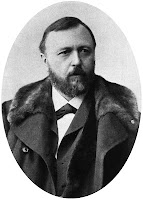[Originally in Past2Present, edition 2 (2009)]
 |
| Karl-Maria Kertbeny |
Karl-Maria Kertbeny (1824-82)
Karl-Maria Kertbeny, also Károly Mária Kertbeny, was born as Karl-Maria
Benkert in Vienna, the son of a writer and a painter. He was an
Austrian-born Hungarian journalist, memoirist and human rights
campaigner who first coined the word ‘homosexual’.
As a young man, while working as a bookseller's apprentice, Benkert had a close friend who was homosexual. This young man killed himself after being blackmailed. It was this tragic episode which led Benkert to take a close interest in the subject of homosexuality, following what he called his "instinctive drive to take issue with every injustice".
After a stint in the Hungarian army, Benkert worked as a journalist and travel writer, and wrote at least 25 books on various subjects, none of any lasting value. He claimed to be "normally sexed" and there is no evidence to contradict this, despite the scepticism of some writers.
Nevertheless, from this time he began to write extensively on the issue of homosexuality, motivated by an "anthropological interest" combined with a sense of justice and a concern for the "rights of man".
In 1869, he anonymously published a pamphlet entitled 'Paragraph 143 of the Prussian Penal Code of 14 April 1851 and Its Reaffirmation as Paragraph 152 in the Proposed Penal Code for the Norddeutscher Bund. An Open and Professional Correspondence to His Excellency Dr. Leonhardt, Royal Prussian Minister of Justice'. It saw the first public use of the word ‘homosexuality’, although he had used it in May of the previous year in a private letter to Karl Heinrich Ulrichs, the German gay-rights advocate.
Before then, there were very few neutral words to describe people who
experienced romantic or sexual attractions toward others of the same
sex. Those used, such as “bugger”, “molly”, “sodomite” or “pederast”,
were loaded with condemnation and shame. But as the budding science of
sexology began to grow, and as same-sex loving defenders began to speak
out about what same-sex love was all about, their first problem was with
how to name it: the “abominable vice” wouldn’t do. A new word was
desperately needed to describe their lives and feelings. The ‘love that
dared not speak its name’ in fact couldn’t; it didn’t have one.
 |
| Karl Heinrich Ulrichs |
Karl Heinrich Ulrichs (1825-95)
The first to try to give it an acceptable name was Ulrichs. In the 1860’s, he described the Urning as a “male-bodied person with a female psyche”, who is sexually attracted to men and not women; the opposite form was Urningin. Ulrichs devised an entire system of classification based on different combinations of attractions and gender roles. Some of these words gained usage in English, although the less foreign-sounding sexual inversion and inverts, to describe homosexuality and homosexuals respectively, fell more naturally to English ears. But they quickly became obsolete, replaced by Kertbeny’s new creation.
In his pamphlets, Kertbeny argued that the Prussian sodomy law, Para. 143 (later Para. 175 of the German Empire’s legal code), violated the "rights of man". He advanced the classic libertarian argument that private consensual sexual acts should not be subject of the criminal law. Recalling his young friend, he argued the law allowed blackmailers to extort money from homo-sexuals and often drove them to suicide.
Kertbeny also believed that homosexuality was inborn and unchangeable, an argument later called the "medical model". This contradicted the dominant view of the time, that men committed "sodomy" out of mere wickedness. Homosexual men, he said, were not by nature effeminate, and he pointed out that many of the great heroes of history were homosexual. He was the first writer to put these now-familiar arguments before the public.
Once self-identified homosexual men, such as Ulrichs, began to campaign for homosexual rights, Kertbeny faded from the scene. If he was homosexual, he was never prepared to say so. In 1880, he contributed a chapter on homosexuality to Gustav Jäger's book Discovery of the Soul, but Jäger's publisher decided it was too controversial and omitted it. Nevertheless, Jäger used Kertbeny's terminology elsewhere in the book.
 |
| Richard von Krafft-Ebing |
In his Psychopathia Sexualis (1886), German sex researcher Richard von Krafft-Ebing, borrowed the terms homosexual and heterosexual from Jäger's book. Krafft-Ebing's work was so influential that these became the standard terms for differences in sexual orientation, superseding Urning.
Kertbeny did not live to see this wide acceptance of his ideas. He died in Budapest in 1882, aged 58. In 2001, sociologist Judit Takács found his tomb in Kerepesi Cemetery, Budapest, the resting place of numerous Hungarian celebrities of the 19th and 20th centuries. The gay community placed a new tombstone over it, and since 2002 it has been a recurring event at Hungarian gay festivals to set a wreath on the grave.
Sources:
http://en.wikipedia.org/wiki/Karl-Maria_Kertbeny
http://www.boxturtlebulletin.com/tag/karl-maria-kertbeny




